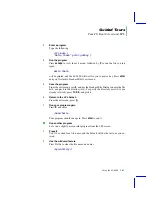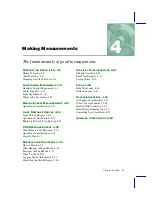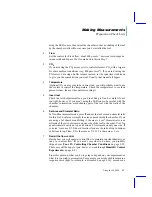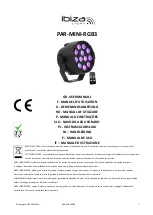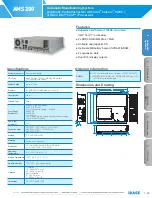
Making Measurements
Some Simple Experiments
Using the LI-6400
4-9
Humidity Control Experiments
wish to operate while making measurements: either a fixed flow rate (with a
potentially variable humidity), or constant humidity (with a potentially vari-
able flow rate). The following experiment will acquaint you with the capabil-
ities and trade-offs involved.
Experiment #1
Finding the Humidity Limits
If you are using the CO
2
mixer, set it to control the reference concentration at
a value slightly above ambient, such as 400 µmol mol
-1
if youÕre outdoors.
1
Operate in fixed flow mode
With the desiccant midway between scrub and bypass, operate in a fixed flow
mode at 400 µmol s
-1
.
2
Match the IRGAs
When
CO2S_µml
and
H2OS_mml
become stable, match the IRGAs.
3
Note the conditions
After matching, note the values that pertain to photosynthesis (
CO2R_µml
,
CO2S_µml
,
D
CO2
, and
Photo
) and the values that pertain to conductance
(
H2OR_mml
,
H2OS_mml
,
RH_S_%
, and
Cond
).
4
Find the upper humidity limit
Set the desiccant on full bypass, and the flow rate to 100 µmol s
-1
. Wait about
one minute, then observe the water numbers. The value of
H2OS_mml
will be
about as high as youÕll be able to achieve with this leaf at this stomatal con-
ductance.
Question #1:
How can the
RH_S_%
value (as opposed to
H2OS_mml
) be
further raised and lowered? (Answer on page 4-53.)
Note that we just dropped the flow rate
F
by a factor of 4 for this step. Since
and
(the complete equations for photo-
synthesis
A
and transpiration
E
are in Chapter 1) it might lead you to believe
that
D
CO2
and
D
H2O
should each have also increased by a factor of 4.
Question #2:
Did you observe a 4-fold increase in
D
CO2
? How about
D
H2O? If you didnÕt, why not? (Answer on page 4-53.)
5
Find the lower humidity limit
Now set the desiccant on full scrub, and increase the flow to 800 µmol s
-1
(it
probably wonÕt achieve that value). Give it a minute or so to stabilize, and ob-
A
CO
2
D
(
)
F
¤
=
E
H
2
O
D
(
)
F
¤
=
Summary of Contents for LI-6400
Page 1: ...Using the LI 6400 Portable Photosynthesis System ...
Page 15: ...Part I The Basics ...
Page 16: ......
Page 174: ...Making Measurements Answers to Questions 4 56 Using the LI 6400 4 ...
Page 175: ...Part II Useful Details ...
Page 176: ......
Page 200: ...Standard Tools Power ON Hooks 5 24 Using the LI 6400 5 ...
Page 214: ...Real Time Data Real Time Graphics 6 14 Using the LI 6400 6 ...
Page 234: ...Environmental Control Light Control 7 20 Using the LI 6400 7 ...
Page 244: ...Light Sensor Considerations Gallium Arsenide Phosphide GaAsP Sensor 8 10 Using the LI 6400 8 ...
Page 288: ...Data Logging Making Your Own AutoPrograms 9 44 Using the LI 6400 9 ...
Page 289: ...Part III Working With Files ...
Page 290: ......
Page 312: ...The LPL File System Troubleshooting 10 22 Using the LI 6400 10 ...
Page 340: ...Downloading Files Using a Data Capture Program 11 28 Using the LI 6400 11 ...
Page 375: ...Part IV Configuration Issues ...
Page 376: ......
Page 420: ...Defining User Variables Old Style vs New Style 15 18 Using the LI 6400 15 ...
Page 454: ...Using an Energy Balance Further Reading 17 12 Using the LI 6400 17 ...
Page 455: ...Part V Maintenance Troubleshooting ...
Page 456: ......
Page 572: ...Troubleshooting Useful Information 20 46 Using the LI 6400 20 ...
Page 593: ...Part VI Programming ...
Page 594: ......
Page 622: ...Programming with LPL Compiler Directives 22 28 Using the LI 6400 22 ...
Page 846: ...Index I 16 Using the LI 6400 ...



